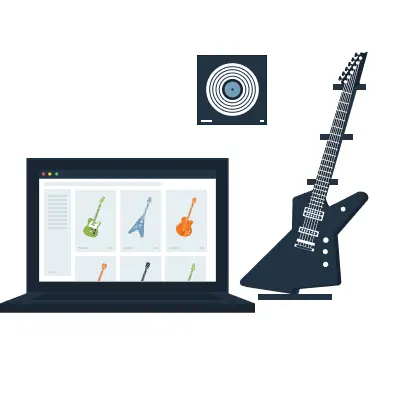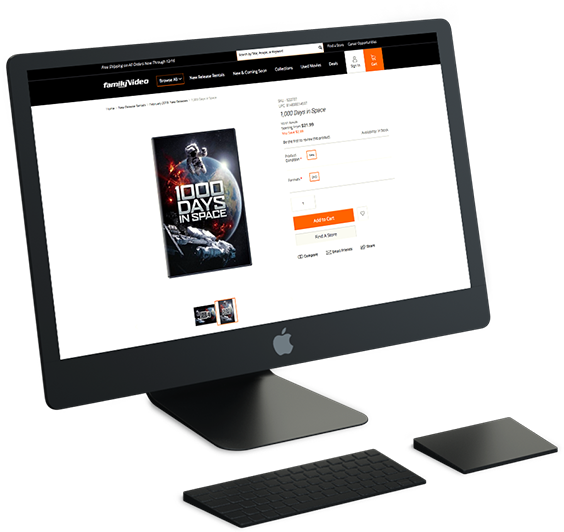Everything You Need to Know About
How to Sell a Guitar Online

Everything You Need to Know About
How to Sell a Guitar Online
Share post
We took a close look at the best stores that sell musical instruments online and determined exactly what makes them the best. Want to know how to sell guitars online and how to develop an ecommerce store? Check out this article to learn how the best stores work, what technologies they use, and how much it might cost to develop an online store.
The global musical instruments market is expected to grow during the next three years and was predicted to reach more than $17 billion in revenue by 2020. There are more than 600 music instrument manufacturers all over the world, so the market is highly competitive. Some of the key producers on today’s music instrument market are Fender, Gibson, Kawai, Roland, Steinway & Sons, and Yamaha.
Table of Contents
ToggleBuying a musical instrument today is as easy as pie. Some people will visit a brick-and-mortar music store nearby to have an opportunity to try an instrument, while others will prefer simple and convenient online purchasing without any fuss. It’s now possible to buy anything with one click and without any worries. And it’s a great time for musical instrument manufacturers and vendors to start their ecommerce activity.
E-stores that sell musical instruments offer diverse products. The price of the product depends on the client budget, purposes and musical skills. From discount guitars and rarity pianos to power amplifiers and mics – online stores offer lots of options to choose from, at a price that suits every pocket. Let’s look at some examples of e-shops:



To build an online store, you can use a content management system (CMS). This system should be modern, responsive, and deeply customizable. Let’s take a look at the most popular and suitable CMSs for a guitar online stores:
To build a guitar online store, the following technologies can be used:
Once you have chosen the proper ecommerce tool and technologies, you can consider some useful integrations for your e-store that will allow you to expand your website’s capability.

When building a guitar e-store, remember to consider your target audience; they’re musicians. The website’s design must appeal to them. We made a rough estimate of how much it might cost to develop an online store for selling music instruments on Magento.
Stage
Estimated Hours
Stage
Specification preparationEstimated Hours
8 – 16
Stage
UI/UX prototyping
Estimated Hours
16 – 44
Stage
Graphical design
Estimated Hours
24 – 84
Stage
Set up musical instruments attribute sets
Estimated Hours
12 – 18
Stage
Set up rules for related/up-sell/cross-sell products
Estimated Hours
12 – 30
Stage
Add-to-cart related customizations for configurable and bundle products
Estimated Hours
6 – 16
Stage
Payment method setup
Estimated Hours
4 – 24
Stage
Shipping method for oversized and non-standard sized items
Estimated Hours
4 – 32
Stage
Additional extensions for musical instruments store setup and configuration
Estimated Hours
6 – 28
Stage
Back-end development project management and quality assurance
Estimated Hours
9 – 30
Stage
Design implementation
Estimated Hours
40 – 120
Stage
Responsive finalization
Estimated Hours
12 – 80
Stage
Magento architecture setup (depends on the number of server instances and complexity)
Estimated Hours
6 – 24
Stage
Live deployment and check
Estimated Hours
3
162 – 549
Additional features that you may like to add to your e-store can be implemented by purchasing paid modules (extensions). As an example, for an online guitar store it’s nice to have Magento modules such as Social Share, Newsletter, Slideshow, Mega Menu, Ajax Cart, Live Chat etc. If you’re not familiar with these tools, we’re always glad to help and provide advice on a cost-effective approach.
As we can see, professional end-to-end Magento development may take anywhere between 162 to 549 hours. The cost may depend on the complexity of the website’s functionality, availability of additional modules, number of items, etc. Costs vary from region to region, with the highest rates found in the USA, Canada, and Western Europe. However, offshore development in Eastern Europe, such as Ukraine or Moldova, can cost 35%-55% less than prices found in North America, or Western Europe, without a loss in quality.
As you probably know, ‘you never get a second chance to create a first impression’. So, to make your design attract more customers, it is necessary to perform:
You can create a custom design for your online store. Or you can purchase a ready-made theme. If you’d rather go with a theme, this theme should fit the music industry style and match your company’s vision. Let’s take a look at some good-looking examples:
SoundBizarre is a stylish Magento 2 theme aimed to attract music lovers and artists to your website. You can change your store’s logo, menu, and numerous widgets to create a custom design. SoundBizzare offers a photo slider and video background to demonstrate your best products and offers, that will help clients to make a purchase. SoundBizzare provides a photo slider and video background to demonstrate your best products and offers that will encourage your customers to make a purchase. You can bundle your template with different modules, such as Social Sharing and Newsletter.
Another theme both for Magento 1 and 2 is CM Moza. The theme is available in five colors, has laconic typography, a well-structured layout, and easy navigation. You can easily customize CM Moza for various types of products. This Magento theme is bundled with many indispensable Magento extensions such as Mega Menu, Slideshow, Ajax Сart, and more than nine customizable static blocks. Furthermore, there is an understandable user-guide and a powerful admin panel to manage your ecommerce store.
For a Wordpress/Woocommerce website, you can choose Melody. It has a clean and elegant design and can be customized according to your needs. As we said before, compatibility with all devices and screen sizes is essential, and Melody greatly emphasizes this. When talking about functionality, this theme has a mega menu, multiple homepages, powerful search tool, quick view product, filter, product details, grid & list view, and many other features. Melody also has plugins to improve your e-store’s capability, such as powerful page builders King Composer and Slider Revolution, that allow you to create responsive sliders with various animation effects, add images, text, and videos.
Here are a few more templates for your guitar ecommerce store:
Building an online guitar store requires a lot of work. You should know your audience’s tastes, preferences, and habits. You should also do some research to know what technologies to use, and what kind of design your customers will want to see. Another essential step is to find web developers who will create an ecommerce website that fits your needs.

Share This Article

 What Chatbot Development Strategies Do Top Ecommerce Brands Use?
What Chatbot Development Strategies Do Top Ecommerce Brands Use?
Pretty! This was a really wonderful post. Thanks for providing this information.
Thanks for the blog post.Really looking forward to read more. Much obliged.
I simply want to tell you that I’m new to blogging and site-building and seriously liked your web site. Likely I’m going to bookmark your blog post . You certainly come with impressive posts. Kudos for sharing your webpage.